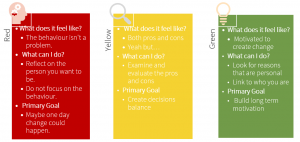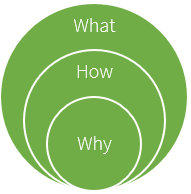We need to engage the Slow Brain or Administrator Brain to affect change. This allows us to assess our readiness for change. Our readiness for change can be blocked into three categories: Red, Yellow and Green.

In order to anchor your motivation for change you need to be clear on your purpose. We work from the outside of “what” to the middle of “how” to the inside of “why”.
- “What” is quite easy to establish as it is the outcome you are looking for.

- “How” is a bit more challenging as you need to figure out what you are going to do and establish a process, plan or strategy to get it done.
- “Why” is the most difficult as it is hard to explain the purpose, cause or belief for change but once it is established, it can increase the likelihood of maintaining or “resetting” our motivation.
Long Term Motivation
There are two ways to anchor long term motivation. First by defining your personal values and second, by establishing goals.
Your personal values are things that are important to you and define who you are as a person. You can link your change to these values.
Steps to setting your personal values:
- Review a list of common values and write down the words that resonate with you
- Group like words together into larger categories (keep it to a maximum of 5 categories).
- Pick one word from the category that resonates the most with you.
- Pick one behaviour you are currently doing that demonstrates each value.
- Pick one behaviour you would like to do that aligns to your values.
- Keep yourself accountable.
- Provide a list of 10 values to three people
- Ask them to pick the 5 they feel best resembles you.
When establishing goals, ensure they are specific, measurable, attainable, relevant and timely (SMART).
Barriers in Motivation to Change
There are two main barriers that can decrease your motivation for change and interfere with the change itself, negative self-talk and the expectation to fail.
Negative Self-Talk

Expectation to Fail
When facing failure with a negative perception it can make the same goal seem less attainable, distort your perception, increase feelings of helplessness, performance anxiety, and create an unconscious “fear of failure” “It isn’t a question of if you will fall off the wagon, but how quickly can you get back on.”
How to Anchor Your Why?
Forming a new habit requires a trigger, motivation and reward to sustain overtime.
Success factors:
- Be clear what you will do.
- Ensure you have competencies.
- What is realistic for you.
- What supports are available to you.
- Make a social contract tell, others about your plan.
- Be mindful of your personal resources (time, money).
- Using small changes, and wins to create larger change.
- Journal/log process important keep a record. When it is written it will get done.
As we establish our new normal post COVID-19, what changes will you make? Why will you make the change? What personal values will you use to instill the change?
Visit maintainingmentalfitness.com to view the full webinar and available resources.



